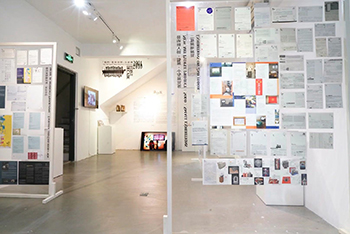Bachelor's degree with a double major in Chinese and Art in Peking University. Master of Art and Administration in New York University. She has served in the Macao Cultural Affairs Bureau, the New York City Department of Cultural Affairs and the Museum of Chinese in America, working as art administrator and curator. She is now working as an art educator and administrator in New York, as well as an independent curator and writer.
Ten years’ sleep
Last year at the year-end, I was curating an exhibition for visiting artists in Macao at the Ox Warehouse. I was also lucky to find that the “We・Art Space” Documentary Exhibition was taking place at the two-storey venue. The exhibition displayed documents from the Ox Warehouse between 2001 and 2010, which gave me the gateway into the past of the Ox Warehouse.
The Ox Warehouse is the most well-known experimental venue for contemporary art in Macao. That is why “We・Art Space” Documentary Exhibition is more or less a documentary exhibition of Macao’s contemporary art. However, the curator appeared to let the audience to write the historical records on their own as the exhibition did not tell many grand stories but mostly showcased promotional leaflets, publications and video documents from the past. Walking among these historical documents, you could almost hear them telling the stories, immersing yourself in history. Is it the time for Macao’s contemporary art to start telling its history?
Two documentary exhibitions, two forms of contemporary documentation
2019 is probably a memorable year that is worth looking back in the future for the cultural community in Macao. Besides the documentary exhibition at the Ox Warehouse, there was also 0—90’s Macao Theatre Document Exhibition curated by the Macao Theatre Culture Institute, which summarised the development of Macao’s theatre scene in the 1990s through relevant historical documents and historical events. The former exhibition reconstructed the past scene of Macao’s contemporary art scene, while the latter documents the history of Macao’s contemporary theatre sector.
Macao Theatre Culture Institute’s documentary exhibition is, in some way, critical. It not only summarises the history of Macao’s theatres but also reflects on public participation in creating art through historical documents. In fact, most of the bibliographies and documentary publications on Macao were written by scholars from elsewhere. The curator of the documentary exhibition on Macao’s theatres points out clearly that there is an urgent need for the theatre industry to document itself and have a reflection. As a matter of fact, the Macao Theatre Culture Institute had already been promoting local theatre reviews and studies when it was established over ten years ago. The institute advocates that “critics and reviews are crucial during golden times and that the ability to document brings power.” The emphasis on documentary and scholarly studies had enabled the local theatre industry to have its history, attaching more significance to every contemporary work created in Macao. I believe this is where historical documentary’s creativity lies in. Documentary is not merely about the past.

“We・Art Space” Documentary Exhibition at Ox Warehouse
In comparison, Macao’s contemporary art community lacks the development of documentary from the grassroots. There is rarely much of a deep discussion or record after an exhibition. Regardless of the scale of an exhibition, you only get to see its name on a brief mention of the newspaper. There is a lack of professional art reviews and other relevant information on the exhibition, let alone documentary of Macao’s contemporary art history. Let’s take the documentary exhibition at the Ox Warehouse as an example. The exhibition was more about displaying documents to visitors instead of showing the history behind. It was not a clear documentary. This perhaps leaves more room for the documentary of Macao’s contemporary art history. But we also need to consider whether this means local artists will continue to neglect the importance of documentary.
From moments of history to an art exhibition
In recent years, Macao has achieved excellent progress in contemporary art. Young talents are starting to see art as a viable career path. Local artists are having more active interaction with both the public and private sectors. Some artists have already achieved commercial success. But overall, Macao’s contemporary art lacks recognition on the regional and international stage. A number of artists who are relatively more experienced also find it hard to have further achievement. This can be attributed to the lack of contemporary art critic and biography in Macao. Just like the exhibition curator Mok Sio Chong once said in an interview: “If you don’t make good documentaries about yourself and only rely on others for a random collection of information, I would think that the situation is not very positive.”
In the long run, professional talents in the contemporary art sector in Macao can learn from the theatre industry and gradually form the ability to document and reflect themselves from the grassroots. This can help drive the development of a mechanism of critics and documentary and nurture professional art critics and commentators in Macao. Only through this way can Macao’s contemporary art creation and exhibition progress and construct an art scene with depth based on history.